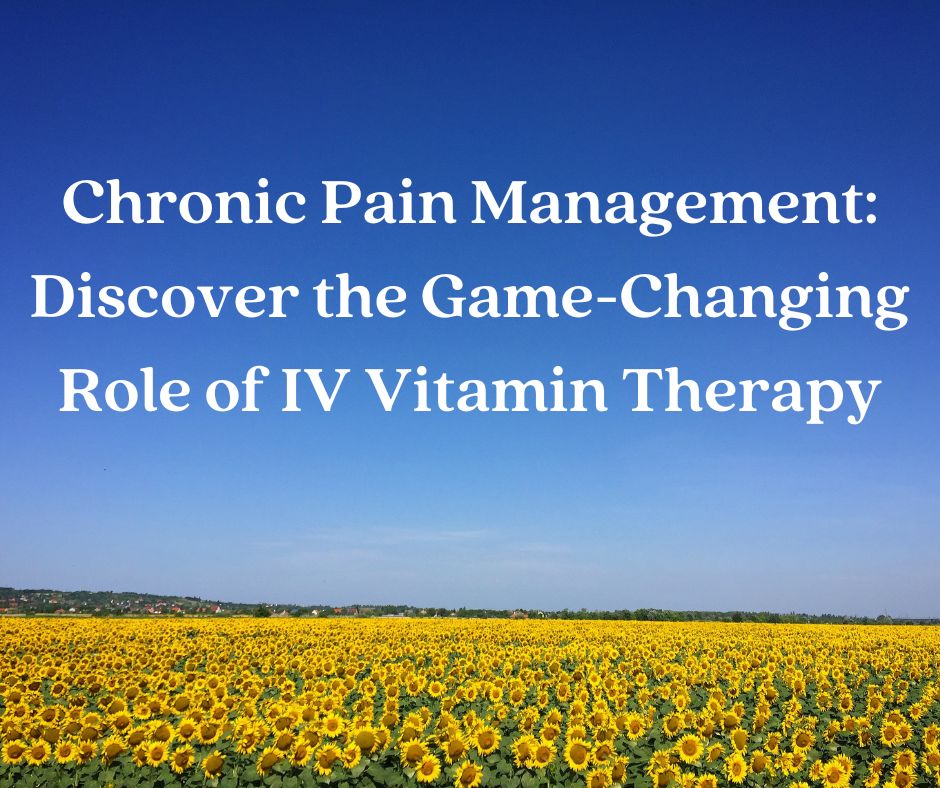Chronic Pain Management: Discover the Game-Changing Role of IV Vitamin Therapy
Hey there, health friend! Ever heard of IV vitamin therapy? If not, you’re about to! And if you have, well, prepare to get to know it even better. IV vitamin therapy is like the VIP lounge for your body – we’re talking direct access, high speed, and no waiting in line. It’s a super-efficient way to deliver vitamins and minerals right where they’re needed most: your bloodstream.
But why are we talking about this? Because there’s a buzz going around that this VIP treatment could be a real game-changer for chronic pain management. Yes, you heard that right. Pain management, that elusive, ever-crucial target for so many of us. We’re about to dive into how IV vitamin therapy might just be a key player in this arena.
Background on IV Vitamin Therapy
Alright, let’s back up a second. What’s this IV vitamin therapy all about? Imagine your favorite smoothie, packed with all kinds of nutrients, but instead of going through your stomach (where there is a cap to absorption), it goes straight into your bloodstream (where trillions of cells are wanting to be nourished). It’s like giving your cells first-class tickets to Nutrient City!
How does it work? Well, by injecting vitamins and minerals directly into your veins, IV therapy bypasses the digestive system, going straight to your blood stream, where they can then be absorbed by your cells. That means no more worrying about whether your gut absorbed all those goodies. They’re delivered direct to the source, ready for action.
But it’s not just a one-size-fits-all arrangement. There are different kinds of IV vitamin cocktails out there. One of the stars of the show is the Myers’ Cocktail. Sounds fancy, right? Named after Dr. John Myers, this mix includes heavy-hitters like magnesium, B vitamins, calcium, and vitamin C. It’s like a power-packed juice blend for your cells! *When it comes to the Myer’s cocktail, it’s very important for you to know how much Vitamin C you are receiving in the cocktail. It can range from 2g to 20g. At Higher Health, we start you at 5g and gradually increase to your optimal dosing. *For pain management, we are delivering 10-20g ideally.
Another popular option is high-dose Vitamin C therapy. We’re talking a lot more Vitamin C than in your morning orange juice. And don’t forget other blends packed with different vitamins, antioxidants, and nutrients, all designed to give your body the top-notch treatment (and nourishment) it deserves.
In the next sections, we’ll explore how these therapies could be the next big thing in pain management. But remember, just like any other treatment, it’s crucial to talk it over with your healthcare provider. Let’s dive in!
Understanding Pain and Its Mechanisms
Have you ever thought about how peculiar pain is? I mean, it’s this thing that can sneak up on you out of nowhere like an unexpected guest or sometimes it just refuses to leave, like that telemarketer that keeps calling. Pain can be a real puzzle, but let’s try to decode it together.
First up, we’ve got acute pain. Think of this as your body’s alarm bell. It’s sharp, it’s sudden, and it’s your body’s way of saying, “Hey, something’s not right here!” It could be from a cut, a burn, or that stubbed toe from the corner of the bed you always forget about.
Then we have chronic pain. This is the stubborn type that hangs around for months, even when the original cause has packed up and left. Conditions like arthritis or back pain often fall into this category. It’s like that annoying song that gets stuck in your head, except it’s not a catchy tune but a constant high-pitched discomfort.
And let’s not forget about neuropathic pain. This one’s a real trickster. It’s when your body sends pain signals even when there’s no clear cause. Imagine getting prank calls but from your own nerves!
Now, how do we usually tackle chronic pain management? We have the usual suspects – over-the-counter medications like ibuprofen or acetaminophen, prescription drugs, physical therapy, or sometimes even surgery. But what if I told you nutrients could also play a role? Intrigued? Let’s dig deeper!
The Role of Nutrients in Pain Management
So, how can nutrients make a difference in chronic pain management? Well, it’s like giving your body the right tools to fight back. Certain nutrients have been found to help turn down the volume on pain and inflammation.
Take magnesium, for example. This wonder mineral acts like a tiny relaxation therapist for your muscles, helping to ease tension and spasms. Low levels of magnesium? That could lead to more muscle pain and headaches. Often the more pain and muscle tension you have, the more magnesium you need simply to manage.
B vitamins are another power team for chronic pain management. They’re like the energy generators of your body. And guess what? Some studies show that they might help soothe neuropathic pain too.
And we can’t forget about our long time friend, Vitamin C. Not just good for staving off colds or supporting skin health, this vitamin is a natural anti-inflammatory and antioxidant. In other words, it’s like your body’s personal superhero, fighting off damage and inflammation that can lead to pain, while also repairing cells!
Intrigued? Buckle up because we’re just getting started on how these nutrients, when delivered straight to your bloodstream, could help unlock a new level of chronic pain management. Ready? Let’s roll!

IV Vitamin Therapy and Pain Management
Ready for some exciting stuff? We’re now delving into how IV vitamin therapy might play a significant role in chronic pain management. Now, this is relatively new territory, but some early studies and patient experiences have been pretty encouraging.
Take, for instance, the Myers’ Cocktail we talked about earlier. Some people who’ve tried this have reported a decrease in their chronic pain, feeling like they’ve got a new lease on life. How amazing is that?
And it’s not just anecdotal evidence; there’s some science to back this up. A study in the Journal of Alternative and Complementary Medicine found that patients with fibromyalgia experienced less pain after receiving the Myers’ Cocktail. Similarly, high-dose vitamin C infusions have shown promise in managing pain, reducing inflammation, and promoting healing. *Remember, it’s important to get the right dose of Vitamin C; much more than 2g!
But you might be thinking, how does this work? Well, it’s actually a straightforward process. You sit back in a comfy chair while a skilled professional inserts a small tube, called a catheter, into your vein. They then attach this to a bag containing the nutrient cocktail which drips slowly into your bloodstream. It’s a bit like getting a regular IV drip at the hospital, but instead of just fluids, you’re getting a supercharged nutrient mix!
Now, this doesn’t mean it’s a magic potion. Everyone’s experience is different, and it might not work for everyone. But the idea that it could provide relief for some is certainly promising!
Benefits and Limitations of IV Vitamin Therapy in Pain Management
Like any other treatment, IV vitamin therapy has its ups and downs. On the bright side, it could offer a whole new approach to chronic pain management. By delivering nutrients directly into the bloodstream, IV therapy ensures that these nutrients are readily available for your body to use. This could potentially lead to a quicker and more effective response to pain, while also healing and repairing damage.
Also, because IV therapy bypasses the digestive system, it might be a helpful alternative for those who struggle with digestive issues or nutrient absorption. PLUS, there’s the potential added bonus of increased energy, improved immune function, and an enhanced sense of wellbeing.
But hold up, before you start seeing everything through rose-colored glasses, let’s talk about the limitations. For starters, more research is needed to fully understand how effective this therapy is for pain management. Also, while IV vitamin therapy is generally safe, there are risks involved, such as infections or vein inflammation, but incredibly rare. We manage these variables and use our training to prevent these circumstances.
And it’s important to remember that this isn’t a cure-all. It should be considered part of a broader chronic pain management plan, alongside other treatments and lifestyle changes. It’s like adding a turbo boost to your car; it can help you go faster, but you still need to steer, change gears, and hit the brakes when needed.
The bottom line? It’s crucial to have a chat with your healthcare provider to figure out if this could be the right path for you. Remember, the journey to pain management is a marathon, not a sprint, and every step counts!
The Future of IV Vitamin Therapy in Pain Management
Okay, folks, let’s put on our future-goggles and take a peek at what lies ahead. IV vitamin therapy, even with its limitations, is stirring up some serious excitement. The world of science never sleeps, and researchers are working round-the-clock to explore the full potential of this innovative therapy.
For instance, there’s ongoing research into how different nutrient combinations could help manage various types of pain. It’s like creating custom-tailored cocktails for specific pain conditions. Personalized pain management? Yes, please!
Moreover, experts are buzzing about the possibility of integrating IV vitamin therapy into a holistic approach to chronic pain management. Imagine if, alongside exercise, anti-inflammatory nutrition, targeted medications, and other therapies, IV vitamin therapy could provide that extra push your body needs to keep pain in check.
But as with any scientific journey, it’s a winding path with lots of twists and turns. Sure, there’s optimism, but there’s also a need for caution and rigorous testing. Scientists and doctors alike agree that we need more studies to nail down the effectiveness, ideal dosages, and potential side effects. But the future sure looks promising!
Conclusion
Wow, what a ride, right? We’ve journeyed through the world of IV vitamin therapy, discovering how it could play a role in chronic pain management. We talked about different types of pain, the potential pain-soothing power of nutrients, and how IV therapy delivers these directly to your bloodstream.
We also touched on the benefits and limitations, underlining that while IV vitamin therapy could be an exciting new chapter in pain management, it’s not a standalone solution. It’s a potential team player in a comprehensive, personalized approach to keeping pain in check.
But maybe you’re still left with questions, curiosity buzzing like a bee in your bonnet. If so, we’ve got good news for you! Why not book a free consultation with one of our naturopathic doctors? They’d be more than happy to discuss IV therapy, chronic pain management, or any other health queries you might have.
Remember, navigating the world of pain management is like being the captain of a ship. You need a good crew, the right tools, and a clear course. And we’re here to help you steer that ship. So, don’t hesitate to reach out and let us be part of your journey to better health. Here’s to smooth sailing, my friends!
Next Steps
And now, it’s time for action! If you’re ready to take the first step towards a more energetic and vibrant life, book your free IV Vitamin Therapy consultation today.
This is your opportunity to ask questions with an IV certified Naturopathic doctor, discuss your specific needs, and explore how IV Vitamin Therapy can help you get back to feeling your best. Don’t wait – take charge of your health and book your consultation now!
Click here to Book Your Free Consultation.
Resources:
Gaby, A. R. (2002). Intravenous Nutrient Therapy: The “Myers’ Cocktail”. Alternative Medicine Review, 7(5), 389-403.
Link: https://pubmed.ncbi.nlm.nih.gov/12410623/
American Chronic Pain Association (ACPA): Offers peer support and education in pain management skills to people with pain and their families. Website: https://www.theacpa.org/
Mayo Clinic – Chronic Pain Management: A comprehensive overview of chronic pain management, including causes, diagnosis, treatments, and coping strategies. Website: https://www.mayoclinic.org/chronic-pain
American Society of Anesthesiologists (ASA) – Pain Management: Offers information on different types of pain and various treatment options. Website: https://www.asahq.org/whensecondscount/pain-management/
The National Institute of Neurological Disorders and Stroke (NINDS): Provides extensive research-based information about pain, including chronic pain. Website: https://www.ninds.nih.gov/Disorders/Patient-Caregiver-Education/Fact-Sheets/Pain-Back-Sheet
Centers for Disease Control and Prevention (CDC) – Chronic Pain: Offers resources for managing chronic pain, including guidelines for prescribing opioids for chronic pain. Website: https://www.cdc.gov/chronicdisease/resources/publications/factsheets/chronic-pain.htm
The American Academy of Pain Medicine (AAPM): Provides resources for patients, including information on various pain conditions and treatment options. Website: http://www.painmed.org/
Pain Management Research Institute (PMRI): Offers resources for pain management, including pain education classes and online resources. Website: https://sydney.edu.au/medicine-health/our-research/research-centres/pain-management-research-institute.html


